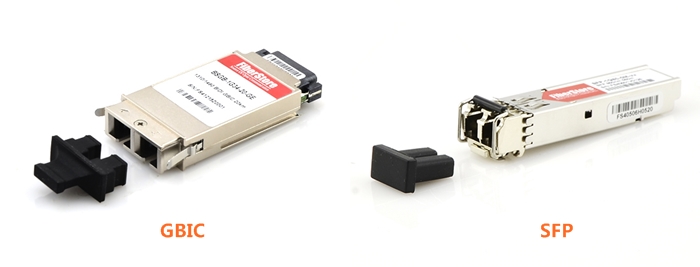GBIC (gigabit interface converter) and SFP (small form-factor pluggable) are both standard form factor for fiber optic transceivers. Basically SFP is smaller than GBIC in size. Both GBIC and SFP have a variety of interface types and each type operates over specific optical fiber type and wavelength. Being not clear of the differences between these two standards, many users do not know when to use which transceiver model, and which line card to choose for their switch/router. Thus, today, we are mainly going to introduce GBIC vs SFP basics, and discuss when it’s best to use GBIC module and when to use SFP module.
GBIC vs SFP: What Is GBIC and What Is SFP?
In order to distinguish these two standards, you should know what they are at first, including their design features and applications.
GBIC and SFP are both hot-swappable input/output devices that plug into a physical port or a slot. GBIC is commonly used with Gigabit Ethernet and Fibre Channel. But its applications are not limited to these two types. There is also Fast Ethernet (FE) GBIC, BIDI GBIC, CWDM GBIC, DWDM GBIC, etc. Generally, GBIC is with the SC connector.
SFP came into existence later than GBIC. SFP transceivers are designed to support SONET (Synchronous Optical Network), Gigabit Ethernet, Fibre Channel, and other communications standards. It is usually with LC connector. SFP is also known as mini-GBIC because it has the same functionality as GBIC but in a smaller form factor.

Figure: GBIC (left) and SFP (right)
For every type of GBIC and SFP transceivers, it works with different wavelengths at a designated location or distance. For example, 1000BASE GBIC/SFP SX uses 850 nm for a maximum of 550 meters over multimode fiber, and 4G Fibre Channel uses 850 nm for a maximum of 150 m. 1000BASE SFP LX uses 1310 nm for a maximum of 10 km over single-mode fiber, and 1000BASE-ZX could reach 80 km. 1000BASE-T uses copper RJ45 interface. The data rate, wavelength and distance information are usually in the name, e.g. 1000BASE-SX GBIC 850nm 550m transceiver, so you can easily identify different GBIC/SFP transceiver models. In addition, both GBIC and SFP are specified to support DOM (digital optical monitoring) function, allowing users to locate the real-time working status of the module.
GBIC vs SFP: When to Use GBIC and When to Use SFP?
According to the above descriptions, you can see the only difference between GBIC and SFP is in the size. But why develop SFP after GBIC?
The fact was because of the big size of GBIC, it was not feasible to provide more interfaces on a switch since it occupies more space. When more interfaces were required on the same line card or switch, the big size of GBIC became a problem. In order to solve this issue people developed SFPs which were smaller size as compared to GBICs. For example, have you ever heard of a 48 port GBIC line card on Cisco 6500 switch? The answer is no, because it’s not feasible to have 48 big GBIC interfaces on the form factor of the line card. But a 48 port SFP line card does exist.
If SFP interface takes less space, why does not abandon GBIC module and use SFP module only? Because it is not always the case that more interfaces are better. Coming to the point when to use what, there are typically two situations. If you already have a switch or line card, using GBIC or SFP depends on the line card or the switch you are having. Usually (not always), the line cards and switches come with empty GBIC and SFP slots where you need to purchase the GBIC and SFP modules separately and insert into those empty slot, just like a 6500 chassis which comes with empty slots and you purchase line cards.
Another case is when you do not have a switch or line card and want to make a decision whether to use a GBIC or SFP. It will actually depend on the number of interfaces required and availability of the switches’ and lines cards’ specific model. For example, if you want two interfaces on a line card in 6500 switch, you won’t go for a 48 port SFP line card, instead you’ll use an 8 port GBIC line card which is available. If you need some 24 fiber interfaces, you won’t use a 16 port GBIC line card, you’ll use a 24/48 port SFP line card.
Table: Gigabit Ethernet interface of Cisco 6500 series switches.
| Gigabit Ethernet Interfaces | |
| Product Description | Part Number |
| 24-Port Gigabit Ethernet Fiber Module | WS-X6824-SFP-2T (with DFC4) |
| WS-X6824-SFP-2TXL (with DFC4XL) | |
| 48-Port Gigabit Ethernet Fiber Module | WS-X6848-SFP-2T (with DFC4) |
| WS-X6848-SFP-2TXL (with DFC4XL) | |
| 48-Port Gigabit Ethernet Copper Module | WS-X6848-TX-2T (with DFC4) |
| WS-X6848-TX-2TXL (with DFC4XL) | |
| Fabric-Enabled 48-Port SFP-Based Gigabit Ethernet Module | WS-X6748-SFP |
| Fabric-Enabled 24-Port SFP-Based Gigabit Ethernet Module | WS-X6724-SFP |
| 16-Port GBIC-Based Gigabit Ethernet Module | WS-X6516A-GBIC |
| 8-Port GBIC-Based Gigabit Ethernet Module | WS-X6408A-GBIC |
GBIC vs SFP: we have discussed when to use GBIC and when to use SFP in this post. You can decide to use GBIC port or SFP port according to your situation and needs. Besides, the GBIC transceiver and SFP transceiver are able to operate over the same fiber. Just be sure the two modules work at the same wavelength and fiber type/size. Usually a proper LC to SC fiber patch cable can help make the link.
Related Article:
SFP Module: What’s It and How to Choose It?





